Disciplinary sanction for non-fulfillment of official duties
If the fact of non-performance or insufficiently conscientious performance of official duties is discovered, the responsible persons have the right to draw up an official note in accordance with the model adopted in this company. About how to draw up such a document correctly, what you need to pay attention to and ready-made examples of notes - in this article.
During work, each employee can record the fact of non-fulfillment of official duties by his colleague (or several colleagues) and initiate (and also write independently) the preparation of an appropriate memorandum according to a certain sample or in any form.
The main purpose of such a measure is to record the actual fact of violation of the internal regulations, for example:
- being late without a valid reason;
- premature departure from work;
- absenteeism;
- appearance in a state of intoxication;
- incorrect performance of their duties;
- inaction that resulted in consequences for the company and/or other employees;
- incorrect communication with colleagues, etc.
It can be used both inside and outside the enterprise. Therefore, they are divided into 2 types:
- Internal - this is the most common option when you need to convey the fact of incorrect work to a higher employee. Usually, the paper is drawn up on the letterhead of the company, in accordance with the instructions provided by the enterprise (if any). To certify the document, it is enough to put only the signatures of the employees who witnessed the incident.
- External - in this case, it is drawn up in the name of representatives of regulatory authorities or in the name of the head of the central office (that is, the document goes beyond the company). Such a paper can be drawn up in connection with the incorrect actions of the manager, about which the employees report to a higher authority. This document must be certified by both signatures and the seal of the organization.
In form, these papers practically do not differ in any way. The main thing is to take care of the evidence base, be ready to defend your point of view, and also take into account several mandatory requirements for compilation, which are discussed below.
How to compose
As a rule, the company has its own samples and rules for compiling reports when it is necessary to record the fact of non-fulfillment of official duties by one or another employee. Therefore, the form and features of the content of the document are arbitrary. The following rules are usually followed:
- First of all, a “cap” is drawn up, in which the full name of the director (or other responsible person) is written in whose name the paper is written. The short name of the company is also indicated.
- Then the name of the document and the number are written (usually in chronological order, which should be clarified in the workflow journal).
- What follows is a brief yet concise statement of the gist of the remark. Describes a fact, an incident that indicates the incorrect performance of official duty, unprofessional actions or inaction. For example, untimely reporting, incorrect filling of documentation, being late, incorrect communication with colleagues, etc.
- After that, you can justify the violation by qualifying it appropriately - for example, under labor law (truancy, appearing in a state of intoxication) or in accordance with the organization's internal regulations (for example, failure to meet a professional standard when serving a customer at the checkout).
- If such actions (or inaction) entailed certain sanctions against the company, this fact should also be described in detail. For example, “as a result of the inaction of the employee Ivanov N.K. the company was fined by the tax inspectorate in the amount of 10,000 rubles.
- Further, the drafters of the paper should clearly state their request, starting the sentence with the word “I offer ...”. Usually, certain disciplinary actions are offered - for example, to reprimand, deprive them of bonuses or even dismiss them.
- Further, each person who participated in the drafting of the text (and was also a direct witness to the incident) puts his signature, and also writes down the surname, initials and full name of the position he currently holds.
Considerations of business ethics preclude the description in the note of any subjective opinions. It is important to understand that the document specifically records the fact of a violation of labor discipline, non-compliance with duties, therefore, the text should reflect only the incident itself and offer a measure of responsibility in relation to an unscrupulous employee.
Who applies to whom
There is no specific single regulation. However, each company has its own procedure - both in writing and orally: usually all memos are submitted to:
- general director;
- his deputy;
- branch manager;
- foreman.
At the same time, such a document is submitted either by senior employees, or those at the same level - that is, precisely those who registered the fact of insufficiently conscientious performance of duties.
Every person in the company has the right to apply with a note to any employee, regardless of his specific position. That is, theoretically, an ordinary employee can write a complaint to the general director against his immediate supervisor. In practice, every company has an unspoken order and its own hierarchy, but in principle, all people have the opportunity to complain.
Registration procedure
In different organizations, the procedure for recording the facts of violations of labor discipline and written confirmation may be different, but in general, the sequence of actions is as follows:
- The fact of violation of discipline, dishonest performance or complete failure to fulfill duties is recorded. You can use audio and video recording tools, involve other employees as witnesses.
- The text of the note is being compiled.
- The paper is certified by a responsible person - as a rule, this is a senior salesman, a shift supervisor, a foreman, a personnel manager and other employees.
- Then the paper is submitted directly to the head in whose name it was drawn up.
- The head considers the appeal on its merits, takes measures and issues its own order (order) or rejects the appeal, if necessary, explaining the reasons for the refusal to the employees who issued it.
Sample and examples
In general, the following form can be taken as a basis:
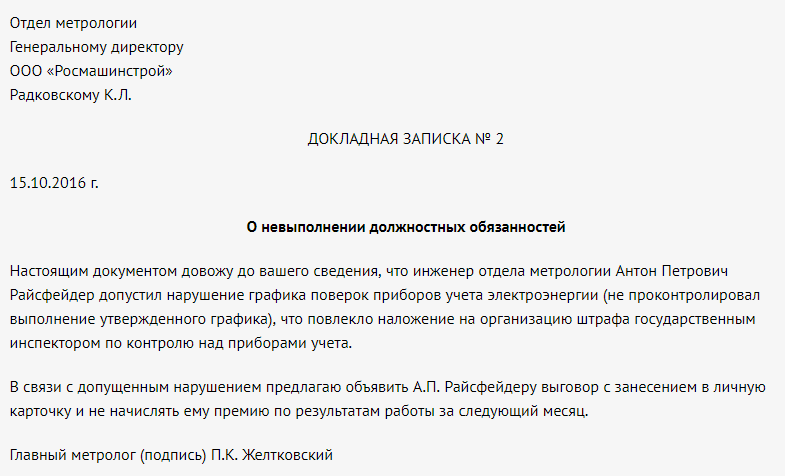
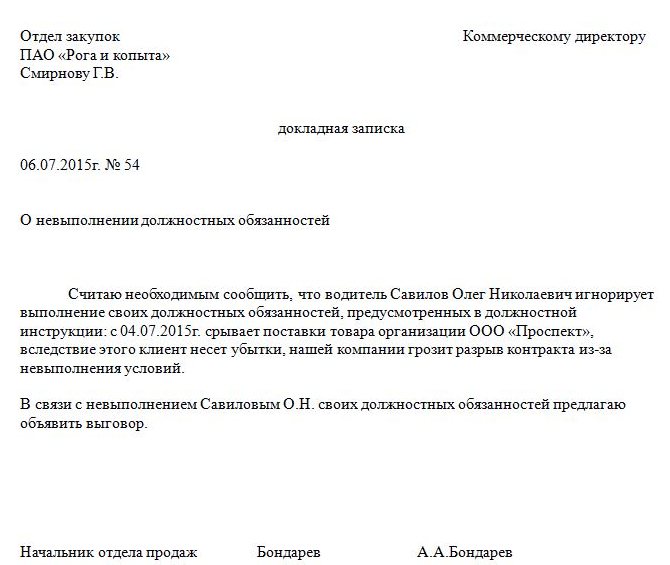
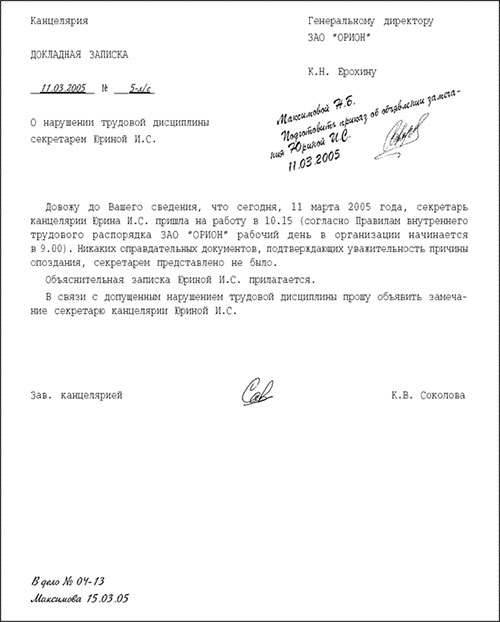

Types of disciplinary sanctions
At the moment, all penalties that can be applied to an employee are reduced to 3 types:
- Written remark.
- Drafting a reprimand.
- Forced dismissal due to insufficiently conscientious performance of work.
At the same time, the Labor Code states that no other types of penalties are allowed to be applied. The management can choose any of these measures, and in some cases it is immediately a reprimand or even dismissal, so the employer is not required to follow the above sequence.
However, the procedure for applying the measure must be taken into account - in general terms, it consists of the following actions:
- The fact of non-fulfillment of official duties is recorded, as a result of which it is possible to draw up a memorandum according to the established model. The execution of this paper is the right, but not the obligation of the employer.
- The employee must be required to draw up an explanatory note - i.e. a written explanation of the reasons for his act (or inaction).
- If he refuses to comply with this requirement, it is necessary to draw up an appropriate act, which is signed by witnesses (colleagues).
- Next, a measure is implemented, which is supposed to be responsible for the act - a remark is recorded, a reprimand is drawn up, or the employee is immediately forcibly dismissed.
It is allowed to record a violation within a maximum of 6 months from the day it was committed by the employee. That is, if an incident is detected after this period, it will be impossible to initiate a disciplinary procedure. However, litigation is not ruled out.
More information about disciplinary actions can be found here.
Reprimand: compilation instructions
After the failure to fulfill official duties was noted, about which a memorandum was drawn up according to the appropriate model, most often employers take two measures - a remark or a reprimand. It is important to understand that only one measure is applied for one misconduct.
As a rule, management makes a decision on reprimand, as reported in a written order (order). At the same time, neither the form of the reprimand nor the form of this order is established, therefore, each company has the right to use its own forms and samples. The document usually contains the following sections:
- Date, place of issue of the order, full official name of the organization.
- The name and number of the order in accordance with the accepted rules of workflow (usually in chronological order).
- Exactly the content of the order. Provides information about the employee (full name, position, personnel number if any, other essential information) and the reason for the reprimand. Links to regulatory documents are described - labor legislation, internal regulations, as well as evidence papers (for example, a memorandum).
- Applications are described - that is, documents that are attached to the order indicating the quantity and type (copy or original).
- The seal is put, the director's signature and decoding (surname, initials).
A sample order is shown below:
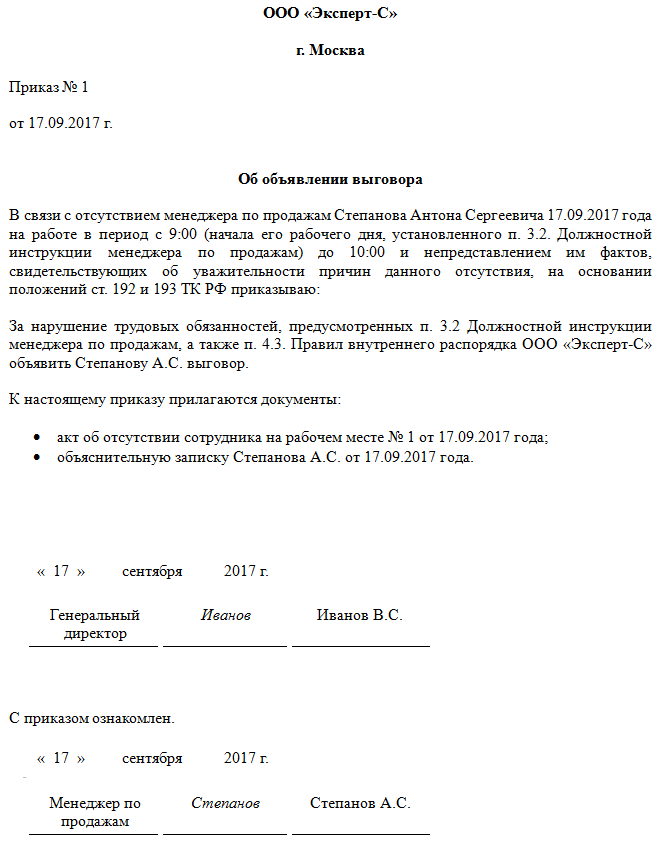
NOTE. The order must always be signed by the employee - it is assumed that by these actions he confirms the fact of familiarization with the text, but this is not equivalent to the fact that he agrees with the content. If an employee refuses to sign, an appropriate refusal certificate is drawn up, which is signed by other employees of the organization who testified to this fact.
 Ready-made business plan with calculations using the example of a web studio
Ready-made business plan with calculations using the example of a web studio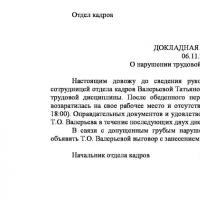 Registration of an internal memorandum: sample document and drafting rules
Registration of an internal memorandum: sample document and drafting rules Break even. Formula. Example of model calculation in Excel. Advantages and disadvantages
Break even. Formula. Example of model calculation in Excel. Advantages and disadvantages Advance report is ... Advance report: sample filling
Advance report is ... Advance report: sample filling How to stitch documents with threads by hand?
How to stitch documents with threads by hand?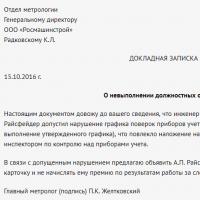 Disciplinary sanction for non-fulfillment of official duties
Disciplinary sanction for non-fulfillment of official duties Binding your book
Binding your book